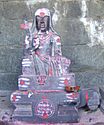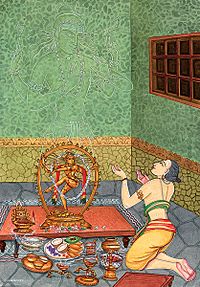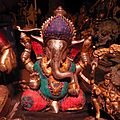Murti facts for kids
Murti (idols, images) of different deities and saints
|
||||||||
In the Hindu tradition, a murti (Sanskrit: मूर्ति, romanized: mūrti, lit. form, embodiment, or solid object) is a devotional image such as a statue, or "idol" (a common and non-pejorative term in Indian English), of a deity or saint. In Hindu temples, it is a symbolic icon.
Not all Hindu images of gods and saints are murti, for example, purely decorative sculptures in temples and on the streets. A murti is itself not a god in Hinduism, but it is a shape, embodiment, or manifestation of a deity. Murti are also found in some nontheistic Jain traditions, where they serve as symbols of revered mortals inside Jain temples, and are worshiped in murtipujaka rituals.
A murti is typically made by carving stone, wood working, metal casting or through pottery. Ancient era texts describing their proper proportions, positions and gestures include the Puranas, Agamas, and Samhitas. The expressions in a murti vary in diverse Hindu traditions, from ugra symbolism to express destruction, fear and violence (Durga, Kali) to saumya symbolism to express joy, knowledge and harmony (Saraswati, Lakshmi). Saumya images are most common in Hindu temples. Other murti forms found in Hinduism include the lingam.
A murti is an embodiment of the divine, the ultimate reality or Brahman, to some Hindus. In a religious context, they are found in Hindu temples or homes, where they may be treated as a beloved guest and serve as a participant of puja. On other occasions, they serve as the centre of attention in annual festive processions; these are called utsava murti. The earliest murti are mentioned by Pāṇini in the 4th century BCE. Prior to that, the agnicayana ritual ground seemed to served as a template for the temple.
A murti (also spelt murthi) may also referred to as a vigraha, pratima or simply deity.
Images for kids
-
A collection of modern-day murti featuring the elephant-headed God, Lord Ganesha.
-
8th-century ivory murti parts from Kashmir. Numerous Hindu and Buddhist temples and sculpture in Kashmir were built and destroyed, during Indian subcontinent's Islamic rule period. During this period, some murti of Hindu deities were preserved in Tibetan Buddhist monasteries.
See also
 In Spanish: Murti para niños
In Spanish: Murti para niños











